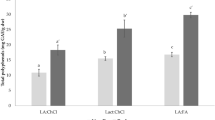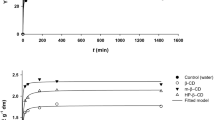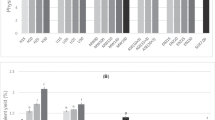Abstract
The objective of the study presented herein was the optimisation of onion solid waste (OSW) polyphenol extraction, using sodium propionate-based deep eutectic solvents (DESs) and process variables optimised through response surface methodology. Initial screening of several novel DESs composed of either L-lactic acid or glycerol as hydrogen bond donors, and sodium propionate as the hydrogen bond acceptor, showed that the DES with glycerol/sodium propionate at a molar ratio 8:1 was the highest-performing system. Extraction optimisation showed that theoretical optimal settings were 85% (w/w) aqueous DES, 100 mL g−1 liquid-to-solid ratio and a stirring speed of 900 rpm. Under these conditions, the temperature assay demonstrated that extraction may be performed at 80 °C, without compromising total polyphenol yield and antioxidant activity. Comparison with other green solvents showed that the DES tested could provide extracts with high flavonoid concentration and superior ferric-reducing power. The stability test performed over a period of 30 days suggested that OSW extract may suffer no significant alterations in the polyphenolic profile, but the antiradical activity may be enhanced. Changes in the antioxidant behaviour were not correlated with changes in the two major OSW constituents, quercetin 4′-O-glucoside and quercetin.
Graphical Abstract







Similar content being viewed by others
Abbreviations
- A AR :
-
Antiradical activity (μmol DPPH g−1)
- C DES :
-
Deep eutectic solvent concentration (% w/w)
- C TFn :
-
Total flavonoid concentration (mg RtE L−1)
- C TP :
-
Total polyphenol concentration (mg CAE L−1)
- dm:
-
Dry mass (g)
- P R :
-
Reducing power (μmol AAE g−1)
- \( R_{\text{mol}}^{{{\text{D}}/{\text{A}}}} \) :
-
HBD/HBA molar ratio (dimensionless)
- R L/S :
-
Liquid-to-solid ratio (mL g−1)
- T :
-
Temperature (°C)
- Y TFn :
-
Yield in total flavonoids (mg RtE g−1)
- Y TP :
-
Yield in total polyphenols (mg GAE g−1)
- AAE:
-
Ascorbic acid equivalents
- CAE:
-
Caffeic acid equivalents
- DES:
-
Deep eutectic solvent
- DPPH:
-
2,2-Diphenyl-1-picrylhydrazyl radical
- GL:
-
Glycerol
- HBA:
-
Hydrogen bond acceptor
- HBD:
-
Hydrogen bond donor
- LA:
-
Lactic acid
- OSWs:
-
Onion solid wastes
- RtE:
-
Rutin equivalents
- TPTZ:
-
2,4,6-Tripyridyl-s-triazine
References
Adjé F, Lozano YF, Lozano P et al (2010) Optimization of anthocyanin, flavonol and phenolic acid extractions from Delonix regia tree flowers using ultrasound-assisted water extraction. Ind Crops Prod 32:439–444
Athanasiadis V, Grigorakis S, Lalas S et al (2017) Methyl β-cyclodextrin as a booster for the extraction for Olea europaea leaf polyphenols with a bio-based deep eutectic solvent. Biomass Conver Biorefin 8:345–355
Bezerra MA, Santelli RE, Oliveira EP et al (2008) Response surface methodology (RSM) as a tool for optimization in analytical chemistry. Talanta 76:965–977
Bi W, Tian M, Row KH (2013) Evaluation of alcohol-based deep eutectic solvent in extraction and determination of flavonoids with response surface methodology optimization. J Chromatogr A 1285:22–30
Cao J, Chen L, Li M et al (2018) Efficient extraction of proanthocyanidin from Ginkgo biloba leaves employing rationally designed deep eutectic solvent-water mixture and evaluation of the antioxidant activity. J Pharm Biomed Anal 158:317–326
Cao Q, Li J, Xia Y, Li W, Luo S, Ma C, Liu S (2019) Green extraction of six phenolic compounds from rattan (Calamoideae faberii) with deep eutectic solvent by homogenate-assisted vacuum-cavitation method. Molecules 24:113
Chen W, Xue Z, Wang J, Jiang J, Zhao X, Mu T (2018) Investigation on the thermal stability of deep eutectic solvents. Acta Phys Chim Sin 34:904–911
Cui Q, Liu J-Z, Wang L-T et al (2018) Sustainable deep eutectic solvents preparation and their efficiency in extraction and enrichment of main bioactive flavonoids from sea buckthorn leaves. J Clean Prod 184:826–835
Dai Y, Witkamp G-J, Verpoorte R et al (2015) Tailoring properties of natural deep eutectic solvents with water to facilitate their applications. Food Chem 187:14–19
Dedousi M, Mamoudaki V, Grigorakis S et al (2017) Ultrasound-assisted extraction of polyphenolic antioxidants from olive (Olea europaea) leaves using a novel glycerol/sodium-potassium tartrate low-transition temperature mixture (LTTM). Environments 4:31
FAO (2016) http://www.fao.org/faostat/en/#data/QC
Furusawa M, Tanaka T, Ito T et al (2005) Antioxidant activity of hydroxyflavonoids. J Health Sci 51:376–378
Huang Y, Feng F, Jiang J et al (2017) Green and efficient extraction of rutin from tartary buckwheat hull by using natural deep eutectic solvents. Food Chem 221:1400–1405
Jablonský M, Škulcová A, Malvis A et al (2018) Extraction of value-added components from food industry based and agro-forest biowastes by deep eutectic solvents. J Biotechnol 282:46–66
Jancheva M, Grigorakis S, Loupassaki S et al (2017) Optimised extraction of antioxidant polyphenols from Satureja thymbra using newly designed glycerol-based natural low-transition temperature mixtures (LTTMs). J Appl Res Med Aromat Plants 6:31–40
Jang M, Asnin L, Nile SH et al (2013) Ultrasound-assisted extraction of quercetin from onion solid wastes. Int J Food Sci Technol 48:246–252
Karageorgou I, Grigorakis S, Lalas S et al (2017) Enhanced extraction of antioxidant polyphenols from Moringa oleifera Lam. leaves using a biomolecule-based low-transition temperature mixture. Eur Food Res Technol 243:1839–1848
Karageorgou I, Grigorakis S, Lalas S et al (2018) Incorporation of 2-hydroxypropyl β-cyclodextrin in a biomolecule-based low-transition temperature mixture (LTTM) boosts efficiency of polyphenol extraction from Moringa oleifera Lam leaves. J Appl Res Med Aromat Plants 9:62–69
Karakashov B, Grigorakis S, Loupassaki S et al (2015) Optimisation of organic solvent-free polyphenol extraction from Hypericum triquetrifolium Turra using Box–Behnken experimental design and kinetics. Int J Ind Chem 6:85–92
Katsampa P, Valsamedou E, Grigorakis S et al (2015) A green ultrasound-assisted extraction process for the recovery of antioxidant polyphenols and pigments from onion solid wastes using Box–Behnken experimental design and kinetics. Ind Crops Prod 77:535–543
Khiari Z, Makris DP (2012) Stability and transformation of major flavonols in onion (Allium cepa) solid wastes. J Food Sci Technol 49:489–494
Khiari Z, Makris DP, Kefalas P (2009) An investigation on the recovery of antioxidant phenolics from onion solid wastes employing water/ethanol-based solvent systems. Food Bioproc Technol 2:337–343
Kiassos E, Mylonaki S, Makris DP et al (2009) Implementation of response surface methodology to optimise extraction of onion (Allium cepa) solid waste phenolics. Innov Food Sci Emerg Technol 10:246–252
Krishnan RY, Rajan K (2016) Microwave assisted extraction of flavonoids from Terminalia bellerica: study of kinetics and thermodynamics. Sep Purif Technol 157:169–178
Ly TN, Hazama C, Shimoyamada M, Ando H, Kato K, Yamauchi R (2005) Antioxidative compounds from the outer scales of onion. J Agric Food Chem 53:8183–8189
Makris D, Kefalas P (2015) Kinetic modelling for polyphenol extraction from onion (Allium cepa) solid wastes using acidified water/ethanol mixture. Acta Alim 44:482–492
Makris DP, Passalidi V, Kallithraka S et al (2016) Optimization of polyphenol extraction from red grape pomace using aqueous glycerol/tartaric acid mixtures and response surface methodology. Prep Biochem Biotechnol 46:176–182
Manousaki A, Jancheva M, Grigorakis S et al (2016) Extraction of antioxidant phenolics from agri-food waste biomass using a newly designed glycerol-based natural low-transition temperature mixture: a comparison with conventional eco-friendly solvents. Recycling 1:194–204
Mouratoglou E, Malliou V, Makris DP (2016) Novel glycerol-based natural eutectic mixtures and their efficiency in the ultrasound-assisted extraction of antioxidant polyphenols from agri-food waste biomass. Waste Biomass Valoriz 7:1377–1387
Mourtzinos I, Menexis N, Iakovidis D et al (2018a) A green extraction process to recover polyphenols from byproducts of hemp oil processing. Recycling 3:15
Mourtzinos I, Prodromidis P, Grigorakis S et al (2018b) Natural food colorants derived from onion wastes: application in a yoghurt product. Electrophoresis 39:1975–1983
Munir M, Kheirkhah H, Baroutian S et al (2018) Subcritical water extraction of bioactive compounds from waste onion skin. J Clean Prod 183:487–494
Pal CBT, Jadeja GC (2019) Deep eutectic solvent-based extraction of polyphenolic antioxidants from onion (Allium cepa L.) peel. J Sci Food Agric 99:1969–1979
Patsea M, Stefou I, Grigorakis S et al (2017) Screening of natural sodium acetate-based low-transition temperature mixtures (LTTMs) for enhanced extraction of antioxidants and pigments from red vinification solid wastes. Environ Proc 4:123–135
Peng X, Duan M-H, Yao X-H et al (2016) Green extraction of five target phenolic acids from Lonicerae japonicae Flos with deep eutectic solvent. Sep Purif Technol 157:249–257
Philippi K, Tsamandouras N, Grigorakis S et al (2016) Ultrasound-assisted green extraction of eggplant peel (Solanum melongena) polyphenols using aqueous mixtures of glycerol and ethanol: optimisation and kinetics. Environ Proc 3:369–386
Pinelo M, Sineiro J, Núñez M et al (2006) Mass transfer during continuous solid–liquid extraction of antioxidants from grape byproducts. J Food Eng 77:57–63
Pucciarini L, Ianni F, Petesse V et al (2019) Onion (Allium cepa L.) skin a rich resource of biomolecules for the sustainable production of colored biofunctional textiles. Molecules 24:634
Rakotondramasy-Rabesiaka L, Havet J-L, Porte C et al (2010) Estimation of effective diffusion and transfer rate during the protopine extraction process from Fumaria officinalis L. Sep Purif Technol 76:126–131
Ramos FA, Takaishi Y, Shirotori M et al (2006) Antibacterial and antioxidant activities of quercetin oxidation products from yellow onion (Allium cepa) skin. J Agric Food Chem 54:3551–3557
Shewale S, Rathod VK (2018) Extraction of total phenolic content from Azadirachta indica or (neem) leaves: kinetics study. Prep Biochem Biotechnol 48:312–320
Slim Z, Jancheva M, Grigorakis S et al (2018) Polyphenol extraction from Origanum dictamnus using low-transition temperature mixtures composed of glycerol and organic salts: effect of organic anion carbon chain length. Chem Eng Commun 205:1494–1506
Vetal MD, Lade VG, Rathod VK (2012) Extraction of ursolic acid from Ocimum sanctum leaves: kinetics and modeling. Food Bioprod Proc 90:793–798
Waldron K (2001) Useful ingredients from onion waste. Food Sci Technol Today 15:38–39
Wang T, Jiao J, Gai Q-Y et al (2017) Enhanced and green extraction polyphenols and furanocoumarins from Fig (Ficus carica L.) leaves using deep eutectic solvents. J Pharm Biomed Anal 145:339–345
Zuin VG, Ramin LZ (2018) Green and sustainable separation of natural products from agro-industrial waste: challenges, potentialities, and perspectives on emerging approaches. Chemistry and chemical technologies in waste valorization. Springer, Berlin, pp 229–282
Author information
Authors and Affiliations
Corresponding author
Ethics declarations
Conflict of interest
The authors declare no conflict of interest.
Additional information
Publisher's Note
Springer Nature remains neutral with regard to jurisdictional claims in published maps and institutional affiliations.
Electronic supplementary material
Below is the link to the electronic supplementary material.
Rights and permissions
About this article
Cite this article
Stefou, I., Grigorakis, S., Loupassaki, S. et al. Development of sodium propionate-based deep eutectic solvents for polyphenol extraction from onion solid wastes. Clean Techn Environ Policy 21, 1563–1574 (2019). https://doi.org/10.1007/s10098-019-01727-8
Received:
Accepted:
Published:
Issue Date:
DOI: https://doi.org/10.1007/s10098-019-01727-8




